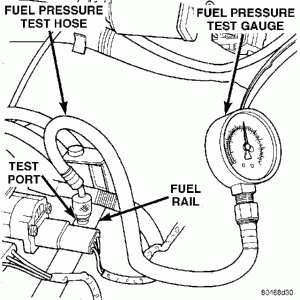Trouble Code:
P0087 Fuel Rail/System Pressure – Too Low

What is the P0087 code mean?
Some vehicles are equipped with a returnless fuel supply, this means that the fuel pump is pulse width modulated and can vary in pump speed to deliver fuel to the rail at a varible rate instead of constantly running the fuel pump and regulating the pressure with a pressure regulator, returning fuel back to the tank.
There is a sensor on the fuel rail that monitors fuel pressure at the rail to determine fuel pressure and vary the pump speed accordingly. The PCM (powertrain control module) or ECM (engine control module) has detected that fuel pressure is below specification for the supply commanded to the fuel pump driver module or fuel pump assembly.
Symptoms
Symptoms of a P0087 DTC may include:
- Check engine light illuminated, there may be more than one code present such as an oxygen sensor lean or rich code.
- Vehicle may have a misfire due to a lean fuel condition, run rough, or lack power on acceleration. This may be more evident at higher RPM’s when more fuel is required. An oxygen sensor too lean code may also be present.
- A bad sensor may cause the PCM/ECM to command extra fuel leading to a rich fuel condition which will cause poor fuel economy. An oxygen sensor too rich code may be present.
Likely Cause:
Potential causes of a P0087 trouble code may include:
- Weak fuel pump, clogged filter or screen, restricted fuel supply line
- Faulty fuel pump driver module
- Faulty fuel pressure sensor
Likely Solutions:
If vehicle is equipped with a fuel pressure test port at the fuel rail or line, check fuel pressure using a mechanical pressure gauge to determine if it is within specifications. Fuel pressure should also be tested under load with vehicle in gear or during acceleration. If fuel pressure is below spefications, visually inspect all fuel lines going back to the tank to see if there is a restriction such as a bent fuel line.
Fuel filter may be clogged if it has not been changed for a long time, or the in-tank fuel screen may have become restricted or clogged – check for damage to the fuel tank that could cause the bottom of the tank to press up against the fuel pump inlet.
Fuel pump driver module equipped vehicles are usually operated on a PWM (Pulse width modulated) input signal from the PCM/ECM and a PWM output signal to the fuel pump, in other words they run on a duty cycle – which is a voltage on/off time rather than a constant voltage to regulate the pump speed. The PWM signal can be checked at the driver module using a wiring diagram for reference and a DVOM set to duty cycle with the positive lead on the signal wire and the negative lead on a good known ground. The duty cycle should vary according to fuel pump demand commanded by the PCM/ECM. Some vehicles such as Ford will double the duty cycle output, so a 30% input will result in a 60% output to the fuel pump. The duty cycle to the fuel pump should reflect this increase. This voltage is usually monitored by the PCM and may set an additional fault code if there is a problem with the fuel pump driver module.
Fuel pressure sensor can be checked using a wiring diagram for reference and DVOM. Typically there is a reference voltage power or ground wire that is monitored by the PCM. A problem with the power or ground wire would typically set a different code such as P0190 – Fuel rail pressure sensor circuit malfunction, or P0191 – Fuel rail pressure sensor circuit range/performance. Excessive resistance in the sensor or wiring leads may lead to an incorrect reading. Using the DVOM set to ohms scale, check the resistance of the pressure sensor by unplugging the sensor and attaching the positive and negative leads to the sensor connector. If the resistance is higher than specifications, replace the sensor. The wiring can be tested using the DVOM set to ohms as well by disconnecting the sensor and the PCM and checking for excessive resistance between the two terminal ends of the wiring harnesses with the positive lead of the DVOM on one end and the negative lead on the other end of the same wire.